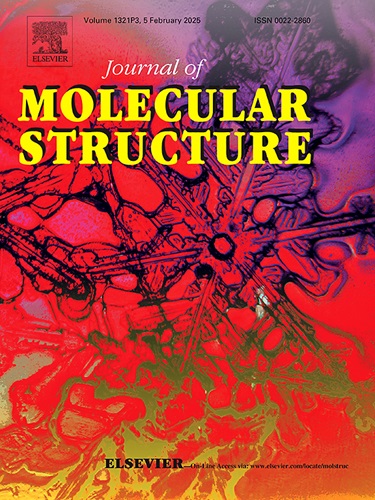Five novel Pb/Zn/Co metal-organic frameworks using 1,4-bis(3-pyridyl)-2,3-diaza-1,3-butadiene and carboxylate ligands: Synthesis, characterization, DFT calculation and catalytic PMS degradation of RhB
IF 4
2区 化学
Q2 CHEMISTRY, PHYSICAL
引用次数: 0
Abstract
Five new metal-organic frameworks (MOFs), namely {Pb(atpt)(3-bpd)0.5}n (1); {Co(cbz)2(3-bpd)(H2O)2·2H2O}n (2); {Co(imdc)(3-bpd)(H2O)·H2O}n (3); {Co(tdca)(3-bpd)(H2O)2·DMF}n (4); {Zn(tdca)(3-bpd)(H2O)2·DMF}n (5), were assembled with metal ions Pb²⁺, Zn²⁺, and Co²⁺ using 1,4-bis(3-pyridyl)-2,3-diaza-1,3-butadiene (3-bpd) as the main ligand, combined with 2-aminoterephthalic acid (H2atpt), 4-cyanobenzoic acid (Hcbz), 4,5-imidazoledicarboxylic acid (H2imdc), and thiophene-2,5-dicarboxylic acid (H2tdca) as auxiliary ligands via hydro/solvothermal methods. Their molecular structures were analyzed by single-crystal X-ray diffraction and characterized by FT-IR and PXRD. Complex 1 has a three-dimensional structure with a hepta-coordinated, semi-directed {PbNO6} metal center. The central metal ions in complexes 2–5 exhibit a six-coordinated {MN2O4} (M = Co or Zn) octahedral geometry. In complex 2, the carboxylate ligand does not function as a bridging ligand, resulting in a 1D chain structure, while complexes 3- 5 extend into 2D layered structures. Thermogravimetric analysis indicates good thermal stability for complexes 1–5. Then, the prepared complexes were used as catalysts to degrade Rhodamine B (RhB) during the monopersulfate (PMS) activation. Complexes 3 and 4 demonstrated significant efficiency, achieving degradation rates of 93.61 % and 98.56 % within 10 min. Radical scavenging experiments and EPR analysis identified that the activation of PMS for dye degradation by the two catalysts occurs through both radical and non-radical pathways, with SO4•− and •OH radicals being the dominant species. Density functional theory (DFT) calculations explained the superior catalytic performance of complex 4 compared to complex 3.
使用 1,4-双(3-吡啶基)-2,3-二氮杂-1,3-丁二烯和羧酸配体的五种新型铅/锌/钴金属有机框架:合成、表征、DFT 计算和催化 PMS 降解 RhB
五种新的金属有机框架(MOFs),即{Pb(atpt)(3-bpd)0.5}n (1);{Co(cbz)2(3-bpd)(H2O)2-2H2O}n (2);{Co(imdc)(3-bpd)(H2O)-H2O}n (3);{Co(tdca)(3-bpd)(H2O)2-DMF}n (4);以 1,4-双(3-吡啶基)-2,3-二氮杂-1,3-丁二烯(3-bpd)为主要配体,与 Pb²⁺、Zn²⁺ 和 Co²⁺ 等金属离子组装成{Zn(tdca)(3-bpd)(H2O)2-DMF}n (5)、结合 2-氨基对苯二甲酸 (H2atpt)、4-氰基苯甲酸 (Hcbz)、4,5-咪唑二羧酸 (H2imdc) 和噻吩-2,5-二羧酸 (H2tdca) 作为辅助配体。通过单晶 X 射线衍射分析了它们的分子结构,并用 FT-IR 和 PXRD 对其进行了表征。络合物 1 具有三维结构,其金属中心为七配位的半定向 {PbNO6}。络合物 2-5 中的中心金属离子呈现六配位的{MN2O4}(M = Co 或 Zn)八面体几何结构。在配合物 2 中,羧酸配体不作为桥接配体,形成一维链状结构,而配合物 3- 5 则延伸为二维层状结构。热重分析表明,1-5 复合物具有良好的热稳定性。然后,将制备的配合物用作催化剂,在单过硫酸盐(PMS)活化过程中降解罗丹明 B(RhB)。络合物 3 和 4 的降解效率非常高,在 10 分钟内分别达到 93.61% 和 98.56%。自由基清除实验和 EPR 分析表明,这两种催化剂通过自由基和非自由基两种途径活化 PMS 以降解染料,其中 SO4-- 和 -OH 自由基是主要物种。密度泛函理论(DFT)计算解释了复合物 4 比复合物 3 更优越的催化性能。
本文章由计算机程序翻译,如有差异,请以英文原文为准。
求助全文
约1分钟内获得全文
求助全文
来源期刊

Journal of Molecular Structure
化学-物理化学
CiteScore
7.10
自引率
15.80%
发文量
2384
审稿时长
45 days
期刊介绍:
The Journal of Molecular Structure is dedicated to the publication of full-length articles and review papers, providing important new structural information on all types of chemical species including:
• Stable and unstable molecules in all types of environments (vapour, molecular beam, liquid, solution, liquid crystal, solid state, matrix-isolated, surface-absorbed etc.)
• Chemical intermediates
• Molecules in excited states
• Biological molecules
• Polymers.
The methods used may include any combination of spectroscopic and non-spectroscopic techniques, for example:
• Infrared spectroscopy (mid, far, near)
• Raman spectroscopy and non-linear Raman methods (CARS, etc.)
• Electronic absorption spectroscopy
• Optical rotatory dispersion and circular dichroism
• Fluorescence and phosphorescence techniques
• Electron spectroscopies (PES, XPS), EXAFS, etc.
• Microwave spectroscopy
• Electron diffraction
• NMR and ESR spectroscopies
• Mössbauer spectroscopy
• X-ray crystallography
• Charge Density Analyses
• Computational Studies (supplementing experimental methods)
We encourage publications combining theoretical and experimental approaches. The structural insights gained by the studies should be correlated with the properties, activity and/ or reactivity of the molecule under investigation and the relevance of this molecule and its implications should be discussed.
 求助内容:
求助内容: 应助结果提醒方式:
应助结果提醒方式:


